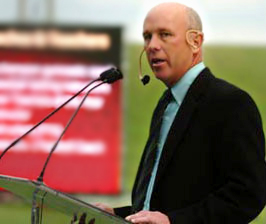16 employees in 8 different cities on 2 different continents serving more than 5 million customers, including some of the world’s biggest brands. How do 37signals do it?
They’re eager to tell you.
Before I take on their book, I’ll give you a sense of the company, which exists almost completely online. They design web-based software that helps you run your small group or business. The table below, including the names and images of each offering, is as stylish and clear as the book. This product/service line was developed for their own use; they run their company on their own applications.

Back to “eager to tell you” … from the 37signals perspective, teaching is marketing. That’s a perspective about which I want to learn more. Of course, they’re eager to teach me.
In addition to countless interviews, speeches, and presentations – many of which are available online (here or here) – founders Jason Fried and David Heinemeier Hansson, along with several other members of the crew, put together a couple books. I’ve read only one of them; this is my review.
Rework is their go at a “general business” book. In it, 37signals explain how they do what they do – how they built and how they run their business. I won’t belabor it in detail, since there are already several tons of love and press about this publication.
In short, they set ablaze conventional wisdom about how business “needs to” or “should” be done. Instead, common sense is put on its proper pedestal …
- Meetings waste time.
- Interruptions slay productivity.
- Resumes are ridiculous.
- Press releases are spam.
- More features do not a better product make.
- And on …
Though the hardcover contains 270+ pages, the layout and style make for a very quick read and begs for a re-read. There are loads of wonderful illustrations accompanying each “verse,” which vary in length from three or four paragraphs to a page or two. Each verse is one of maybe a half dozen pieces that make up a chapter.
It makes sense that Seth Godin‘s endorsement stripes the top of the cover. Rework is a collection of short essays as efficient as Godin’s blog posts. An idea is introduced, supported by an example or two, then wrapped up. The lessons are communicated so cleanly that they seem overwhelmingly obvious. The writing is so straightforward and clear that these essays read in sequence as a series of punches.
As a sample, here’s the lead from the “Speed Changes Everything” verse from the “Damage Control” chapter:
‘Your call is very important to us. We appreciate your patience. The average hold time right now is sixteen minutes.’ Give me a fucking break.
As you might expect of a book that torches conventional wisdom about hiring, PR and marketing, growth, culture, management, venture capital and so much more, Rework is irreverent and refreshing.
Needless to say, I recommend the book highly – especially for those with an entrepreneurial bent. Really, though, it’s a must-read for anyone interested in the structure and running of an organization. For no other reason, you should read it for the gentle but meaningful open-hand slap to the face it’ll give you about what’s happening in your day-to-day work life.
I may write a couple of follow-up posts about how the book functions as marketing and manifesto for the 37signals community and about the other companies 37signals name checks as illustrations of their points.
In the meantime, I’ll leave you with this interview of Jason Fried from O’Reilly Media:
Also, here’s a link to the 37signals “about us” page with company history, executive team profiles, statement of beliefs, and more.



